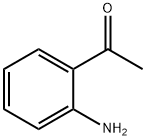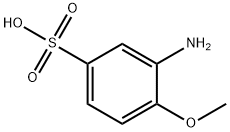o-Anisidine , 1000μg/ml,inPurgeandTrapMethanol , 90-04-0
Synonym(s):
2-Aminoanisole;2-Methoxyaniline
CAS NO.:90-04-0
Empirical Formula: C7H9NO
Molecular Weight: 123.15
MDL number: MFCD00007688
EINECS: 201-963-1
PRODUCT Properties
| Melting point: | 3-6 °C(lit.) |
| Boiling point: | 225 °C(lit.) |
| Density | 1.092 g/mL at 25 °C(lit.) |
| vapor pressure | <0.1 at 25 °C (NIOSH, 1994) |
| refractive index | n |
| Flash point: | 210 °F |
| storage temp. | Refrigerator |
| solubility | 14g/l |
| form | Powder/Solid |
| pka | 4.52(at 25℃) |
| color | Off-white |
| PH | 7.3 (1g/l, H2O, 20℃) |
| Water Solubility | 13 g/L (20 ºC) |
| Sensitive | Light Sensitive |
| Merck | 14,667 |
| BRN | 386210 |
| Henry's Law Constant | 1.25 at 25 °C (approximate - calculated from water solubility and vapor pressure) |
| Exposure limits | Potential occupational carcinogen. NIOSH REL: TWA 0.5 mg/m3, IDLH 50
mg/m3; OSHA PEL: TWA 0.5 mg/m3; ACGIH TLV: TWA 0.1 ppm (adopted). |
| Dielectric constant | 5.2300000000000004 |
| Stability: | Stable. Incompatible with strong oxidizing agents, acid anhydrides, chloroformates, acids, some plastics, rubber. Air sensitive. |
| InChIKey | VMPITZXILSNTON-UHFFFAOYSA-N |
| LogP | 1.180 |
| CAS DataBase Reference | 90-04-0(CAS DataBase Reference) |
| NIST Chemistry Reference | Benzenamine, 2-methoxy-(90-04-0) |
| IARC | 2A (Vol. Sup 7, 73, 127) |
| EPA Substance Registry System | o-Anisidine (90-04-0) |
Description and Uses
o-Anisidine was produced commercially in the United States from the 1920s until late 1950s. By 2009, worldwide only six industries manufactured o-anisidine, but none produced hydrochloride salt. o-Anisidine was available from 44 suppliers, including 20 US suppliers, and the hydrochloride salt was available from eight suppliers, including five US suppliers. US imports of o-anisidine and its hydrochloride salt are reported in the category ‘o-anisidines, p-anisidines, and p-phenetidine,’ and US exports are reported in the category ‘anisidines, dianisidines, phenetidines, and their salts.’ From 1989 to 2008, imports ranged from a high of over 4.6 million kg in 1996 to zero in 2007 and 2008, and exports ranged from zero to 262 000 kg. Reports filed under the US Environmental Protection Agency’s (EPA) Toxic Substances Control Act Inventory Up Rule indicated that United States production plus imports of o-anisidine totaled 500 000 lb–1 million lb in 1986, 1990, and 2006; 1 million–10 million lb in 1990 and 1998; and 10 000–500 000 lb in 2002.
In the preparation of azo dyes; corrosion inhibitor; chemical intermediate
Safety
| Symbol(GHS) |   GHS06,GHS08 |
| Signal word | Danger |
| Hazard statements | H301+H311+H331-H341-H350 |
| Precautionary statements | P201-P280-P301+P310+P330-P302+P352+P312-P304+P340+P311 |
| Hazard Codes | T,Xi |
| Risk Statements | 45-23/24/25-68 |
| Safety Statements | 53-45 |
| OEB | C |
| OEL | TWA: 0.5 mg/m3 [skin] |
| RIDADR | UN 2431 6.1/PG 3 |
| WGK Germany | 3 |
| RTECS | BZ5410000 |
| F | 8 |
| TSCA | Yes |
| HazardClass | 6.1 |
| PackingGroup | III |
| HS Code | 29222200 |
| Hazardous Substances Data | 90-04-0(Hazardous Substances Data) |
| Toxicity | Acute oral LD50 for rats 2,000 mg/kg, wild birds 422 mg/kg, mice 1,400 mg/kg, rabbits 870 mg/kg (quoted, RTECS, 1985). |
| IDLA | 50 mg/m3 |




